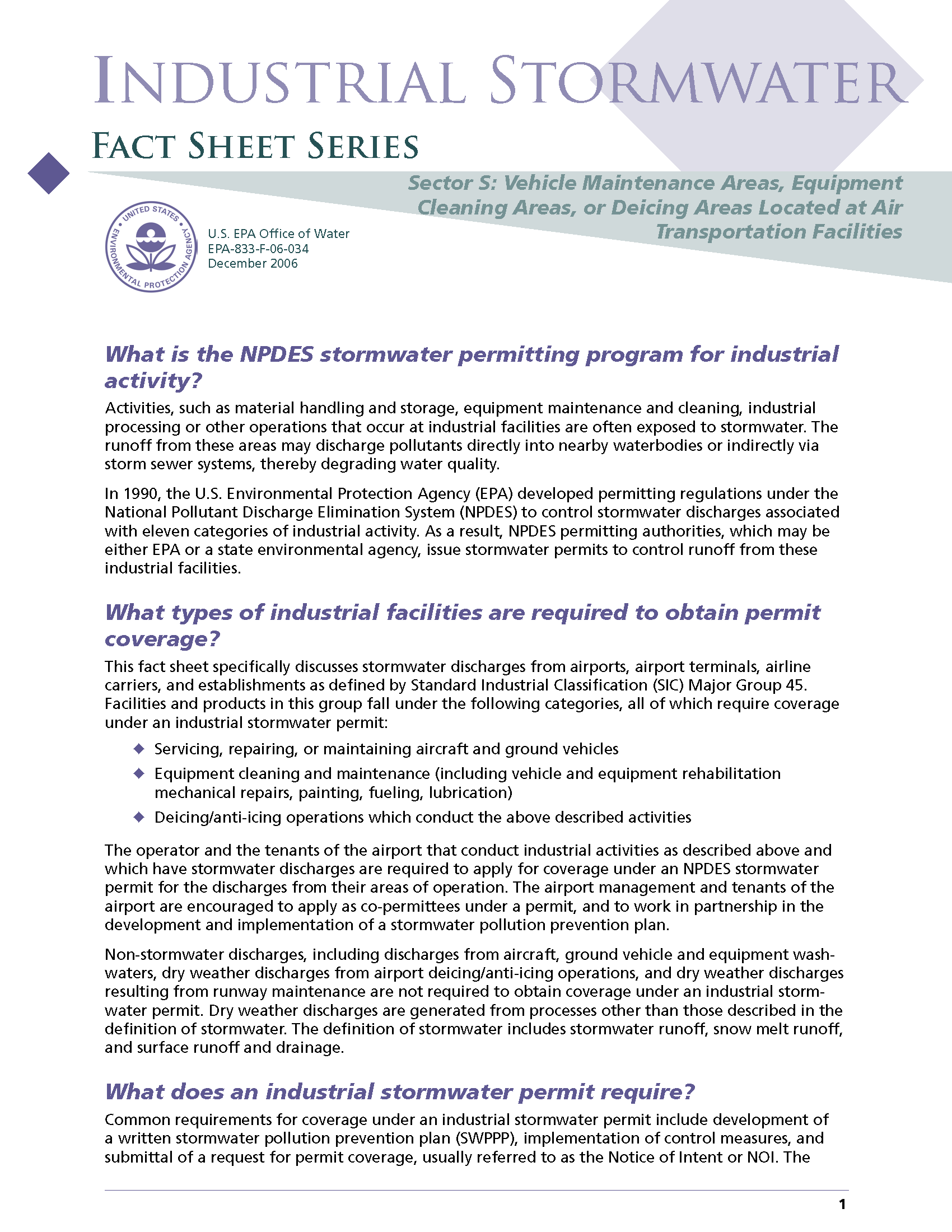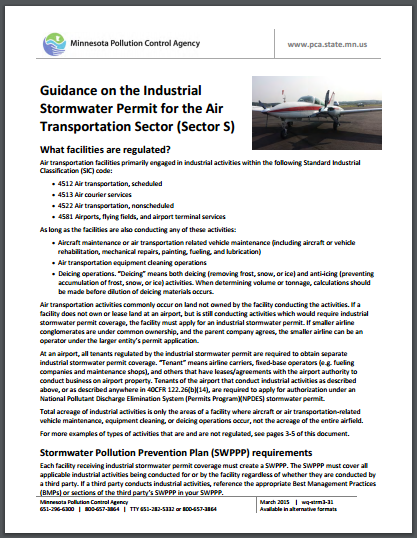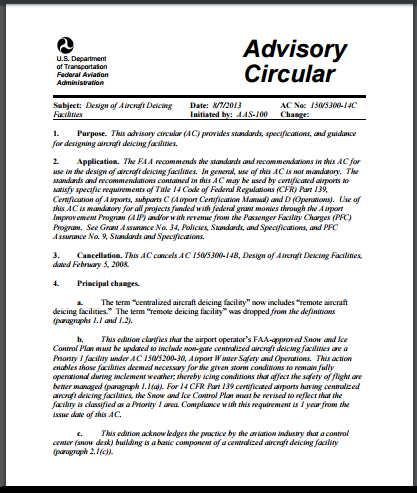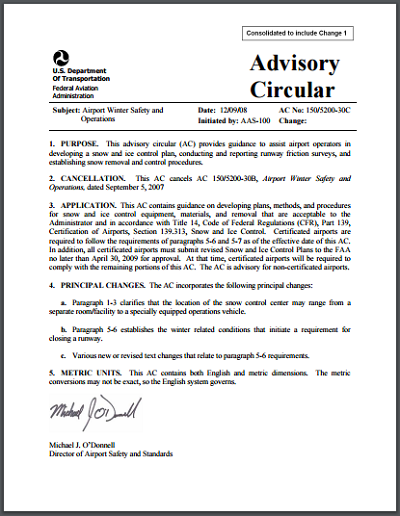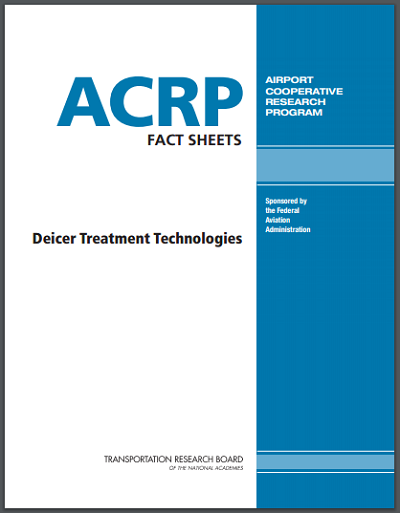< Return to Pollutants & Sources
Airport Stormwater Pollutants and Sources
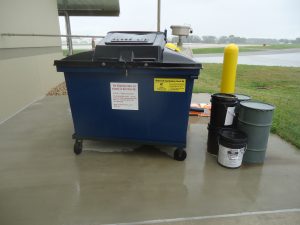
A wide range of activities and sources can contribute pollutants to airport stormwater. These include activities that are unique to the airport environment as well as sources that impact stormwater in many other settings.
Sources that are directly related to aircraft operations include deicing, aircraft and vehicle maintenance, airfield pavement maintenance, and equipment cleaning.
Some of the associated pollutants, such as aircraft deicers, are entirely unique to the airport setting and operations. Source activities that are shared in common with non-aviation environments include landscape maintenance, roadway deicing, litter and trash, vehicle fueling, spills, pet waste, and application of pesticides and fertilizers.
This page identifies resources regarding stormwater pollutants and sources that airports may be required to manage. Because there is a wealth of readily available information regarding pollutants from municipal and urban activities that may be present at airports, the emphasis here is on activities and pollutants that are specific to airports.
ACRP Resources
Topics related to airport stormwater management have been a major part of ACRP’s environmental research since its inception. The following products of that research include information on stormwater pollutants and their sources. Click the blue link to view/download the document.
ACRP Report 14: Deicing Planning Guidelines and Practices for Stormwater Management Systems This planning guidebook for airport deicing runoff management includes a discussion about the constituents in aircraft and airfield pavement deicers.
ACRP Web-Only Document 3: Formulations for Aircraft and Airfield Deicing and Anti-icing: Aquatic Toxicity and Biochemical Oxygen Demand This report provides information on the environmentally-relevant characteristics of aircraft and airfield deicers. It includes tables of Biochemical Oxygen Demand and Chemical Oxygen Demand values for most commonly used aircraft and airfield deicers.
ACRP Research Report 173: Use and Potential Impacts of AFFF Containing PFASs at Airports This guidebook includes information on per- and polyfluoroalkyl substances (PFASs) found in aqueous film-forming foam (AFFF) used by airport firefighting departments, and a class of chemicals that are of potential concern as stormwater pollutants.
ACRP Research Results Digest 21: Best Practices for General Aviation Aircraft Fuel-Tank Sampling This digest summarizes several best practices for general aviation fuel-tank sampling. As part of a typical general aviation internal combustion engine preflight inspection, the pilot normally takes fuel samples from fuel system drains. Although these fuel samples can be returned to the fuel tank if they are uncontaminated, or disposed of in an approved container if contamination is found, it is generally acknowledged that many pilots simply discard the fuel samples to the ground surface. This disposal practice is inconsistent with many airport pollution prevention procedures and environmental regulations and can lead to stormwater runoff contamination.
Other Airport-Specific Stormwater Resources
Florida Statewide Airport Stormwater Best Management Practices Manual This manual sets forth the procedures and criteria for design of individual airside stormwater facilities or master planning airport airside stormwater management systems. (Note: Auto Download PDF)
Technical Report for the Florida Statewide Airport Stormwater Study This technical report describes a statewide study of pollutants found in airport stormwater. It includes tables of water quality parameters and test methods, as well as results of storm event samples collected at a wide range of airports.
“Oxygen Demand of Aircraft and Airfield Pavement Deicers and Alternative Freezing Point Depressants” (S. Corsi, D. Mericas and G. Bowman, Water, Air, & Soil Pollution, DOI 10.1007/s11270-011-1036-x, 2012) This article describes the results of rigorous laboratory analyses of aircraft and pavement deicing formulations and other potential freezing point depressants for chemical and biochemical oxygen demand and oxygen demand. The testing was conducted at different temperatures and under freshwater and marine salinities.
General Resources on Stormwater Pollution
Source Loading and Management Model (SLAMM) Manual: A Water Quality Management Planning Model for Urban Stormwater Runoff This WinSLAMM Model manual contains a compilation of research data on pollutants in urban runoff which could be considered similar in nature to airport runoff.
National Pollution Discharge Elimination System (NPDES) Search the EPA website for a wide range of technical and planning resources related to the NPDES program.
Note: All external links were functional at the time this website was published. If a link is broken, use the title of the document to search for an updated link.


